Wind energy is a way the sun's power impacts our planet indirectly. Solar heating causes air to move and creates wind. Irregular solar radiation levels create atmospheric differences that result in wind currents. This wind energy then rotates wind turbine blades, which convert the sun's power into electricity. So, when you see wind turbines spinning, you're witnessing the sun's influence in action. If you want to learn more about this fascinating connection between wind energy and solar power, keep exploring the ways they are intertwined.
Key Takeaways
- Solar heating creates air pressure variations that drive wind currents.
- Wind patterns result from solar radiation influencing temperature variations.
- Wind turbines convert solar energy captured in wind into electricity.
- Solar radiation sets air in motion, indirectly powering wind generation.
- Wind energy is a renewable byproduct of the sun's energy.
Solar Heating Creates Wind Currents
Solar heating creates wind currents by causing differential heating of the Earth's surface, driving the movement of air and ultimately leading to the generation of wind energy. Wind energy is considered an indirect form of solar energy because it relies on the sun's heat to set the winds in motion.
As the sun's rays hit the Earth, different surfaces absorb heat at varying rates, creating temperature differences that trigger air circulation. This air movement is what we feel as wind.
The concept of wind energy being an indirect form of solar power highlights the interconnectedness of natural processes. By harnessing wind currents through turbines, we can convert this kinetic energy into electricity. It's fascinating to think that every gust of wind is a product of the sun's energy, making wind power a renewable and sustainable resource.
Understanding the relationship between solar heating and wind generation allows us to appreciate how wind energy is fundamentally a byproduct of the sun's influence on our planet. So next time you feel the wind on your face, remember that it's the sun's energy at work, turning breezes into a valuable source of power.
Uneven Solar Radiation Causes Wind
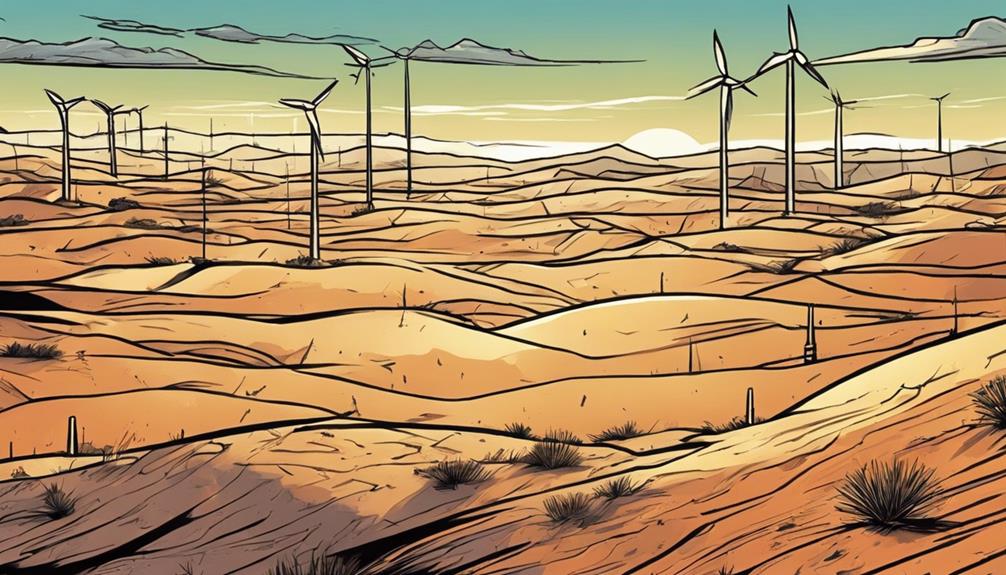
The concept of wind energy being an indirect form of solar power underscores the role of uneven solar radiation in creating wind patterns around the globe.
Solar radiation, as it hits the Earth, causes uneven heating due to the curvature of the planet. This variance in temperature between the equator and the poles leads to the formation of wind currents.
Warm air rises at the equator, creating a low-pressure area, while cooler air rushes in from surrounding regions to balance the pressure. This movement of air, initiated by the sun's energy, results in wind currents that flow across the Earth.
These wind patterns, driven by the sun's uneven heating, are a fundamental component in the generation of wind energy. By understanding the relationship between solar radiation and wind formation, we can appreciate how wind energy indirectly captures the power of the sun through the movement of air.
Wind Turbines Convert Solar Energy
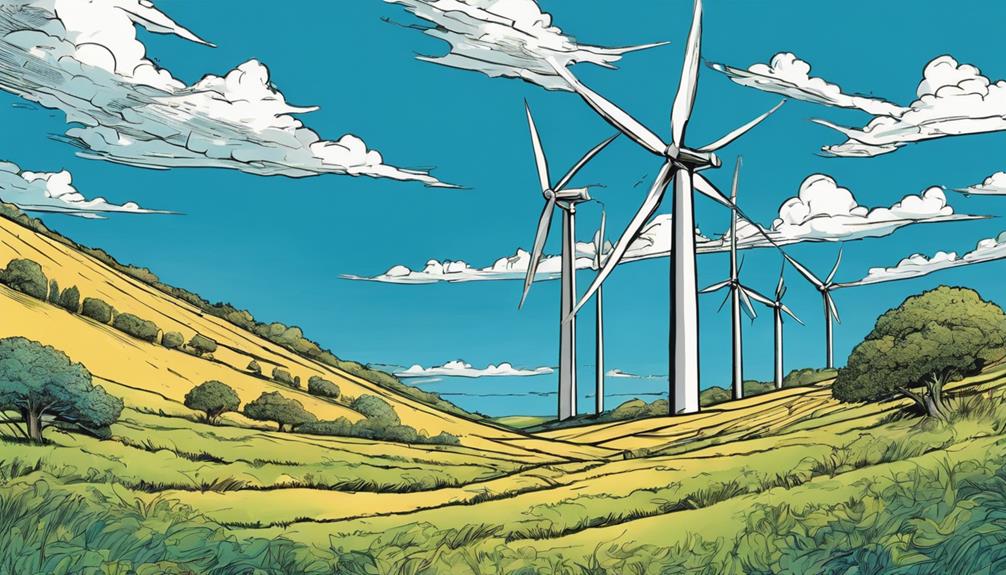
You know that wind turbines play an important role in converting solar energy into usable electricity.
The sun's influence on Earth's climate creates wind patterns that are then harnessed by these turbines.
Solar Influence on Wind
Harnessing wind energy through wind turbines involves converting the kinetic energy of moving air into mechanical power, ultimately derived from solar energy's influence on atmospheric processes. Solar radiation heats the Earth's surface unevenly, leading to temperature variations that create air movement and wind patterns.
These wind currents are a direct result of the sun's heat, making wind energy an indirect form of solar power. The rotation of wind turbine blades is powered by the energy contained in these wind currents, demonstrating the direct link between solar influence and wind energy generation.
Wind Turbines' Solar Conversion
Wind turbines indirectly convert solar energy by capturing the kinetic energy of moving air, which originates from the sun's uneven heating of Earth's surface.
Here's how wind turbines harness solar energy to generate power:
- Kinetic Energy Conversion: As the wind blows, it causes the blades of a wind turbine to rotate. This rotational movement converts the kinetic energy of the wind into mechanical energy within the turbine.
- Mechanical to Electrical Energy: The mechanical energy produced by the spinning blades is then transferred to a generator, where it gets converted into electrical energy. This electricity can be fed into the grid to power homes, businesses, and more.
- Sun-Powered Wind: Ultimately, wind power is a product of the sun's influence on Earth's climate. The sun's heat creates temperature differences that drive wind patterns, which in turn power the turbines. This interconnected relationship showcases how wind energy is fundamentally a form of solar energy, albeit indirectly.
Wind Energy Originates From Sun
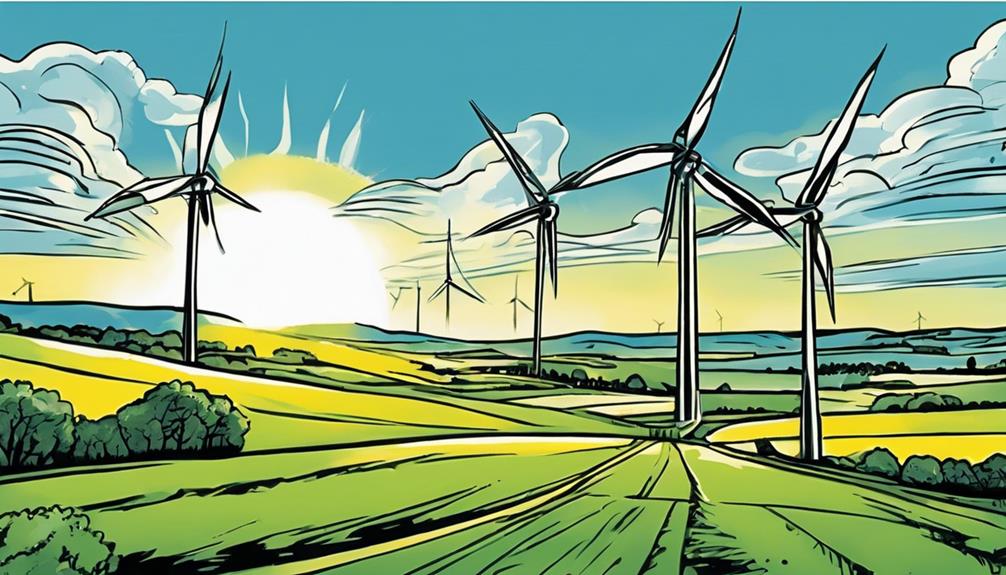
Often overlooked, the origin of wind energy can be traced back to the sun's influence on the Earth's atmospheric conditions. Wind energy is considered an indirect form of solar energy because it's the sun's energy that sets the air in motion, creating wind currents. The sun unevenly heats the Earth's surface, causing warm air to rise and cool air to rush in, generating wind.
This constant cycle of heating and cooling creates the air movements that we harness for power generation through wind turbines.
Essentially, wind power is a byproduct of the sun's effect on the Earth's climate and weather patterns. The sun's energy drives the Earth's weather systems, which in turn produce the wind that we utilize as a renewable energy source. Wind turbines play a pivotal role in converting the kinetic energy of the wind into usable electricity, highlighting the interconnected relationship between wind energy and solar energy.
Solar Warming Generates Wind
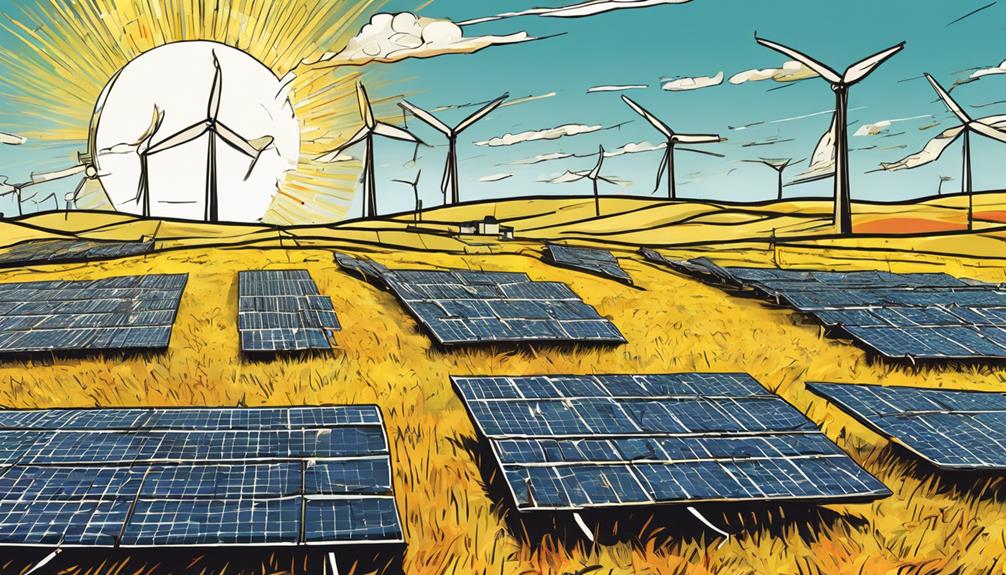
Solar warming plays an essential role in generating wind, as the sun's energy heats the Earth's surface unevenly, creating variations in air pressure.
This difference in pressure causes air to move from high to low-pressure areas, resulting in the formation of wind currents.
Ultimately, the movement of air due to solar warming is the driving force behind wind generation and the subsequent production of wind energy.
Solar Influence on Wind
The uneven heating of the Earth's surface by the sun generates wind currents through the creation of temperature differences. This solar warming effect plays a pivotal role in the formation of winds that can be harnessed for energy production. Here's how the solar influence on wind manifests:
- Solar warming causes air to heat unevenly at different parts of the Earth, such as the equator and poles, leading to temperature variations that drive wind movements.
- As warm air rises and cool air sinks, a convection process is initiated, creating air circulation patterns that result in wind currents.
- These wind currents, produced by the sun's energy, flow across the Earth's surface and can be captured by wind turbines in wind farms to generate electricity efficiently.
In essence, the sun's energy initiates the Earth's atmospheric processes, setting the stage for wind energy production through the utilization of wind turbines in wind farms.
Wind Generation Process
The process of wind generation is intrinsically linked to the solar warming of air, forming the foundation for harnessing wind energy through wind turbines. As the sun heats the Earth's surface unevenly, it creates temperature variations that lead to the movement of air masses. This movement, driven by the sun's energy, results in the formation of wind currents. Wind turbines are strategically placed in areas with high wind speeds to capture this kinetic energy and convert it into electricity. By tapping into these wind currents, wind energy becomes an indirect form of solar energy, as it is ultimately the sun's heat that sets the entire process in motion.
| Wind Generation Process | Solar Influence |
|---|---|
| Solar warming of air creates temperature differences | Solar energy heats the Earth's surface unevenly |
| Air moves from high to low pressure areas, generating wind currents | Air movement driven by the sun's energy |
| Wind turbines harness kinetic energy from wind currents | Wind energy indirectly derived from solar energy |
Sun Indirectly Powers Wind
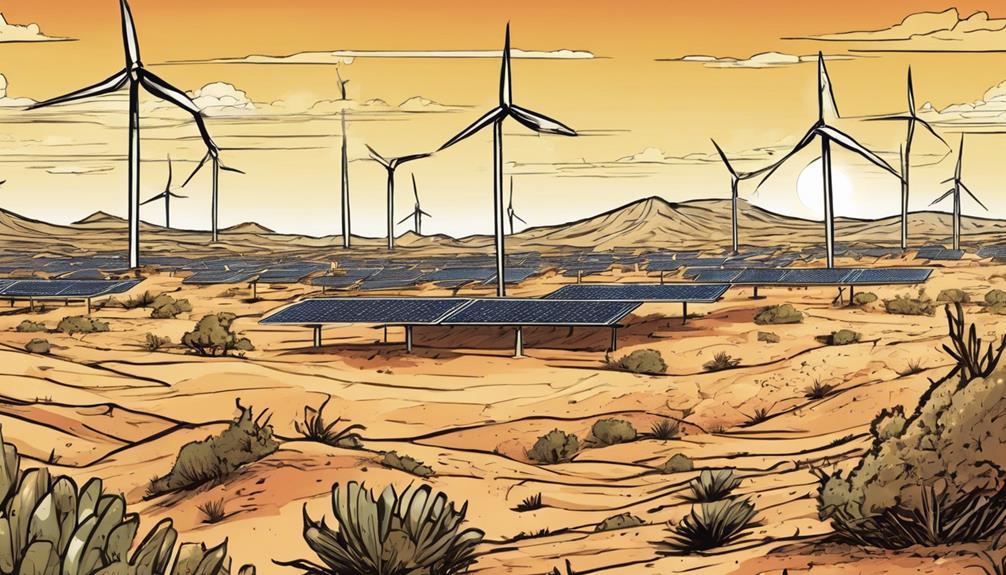
Harnessing wind energy involves recognizing how the sun indirectly influences the generation of wind power. The sun's energy plays a pivotal role in powering the wind turbines that produce electricity.
Here are three key ways in which the sun indirectly powers the wind:
- Solar Heating: The sun's rays heat the Earth's surface unevenly, causing variations in temperature. This temperature disparity leads to the creation of wind as air masses move to balance out the temperature differences.
- Weather Patterns: Solar energy drives the Earth's weather systems, resulting in the development of wind currents. These wind patterns can be harnessed by wind turbines to generate energy.
- Kinetic Energy Conversion: Wind turbines convert the kinetic energy of moving air into mechanical energy through the rotation of their blades. This mechanical energy is then transformed into electricity for various uses.
Wind Turbines Harness Solar Energy
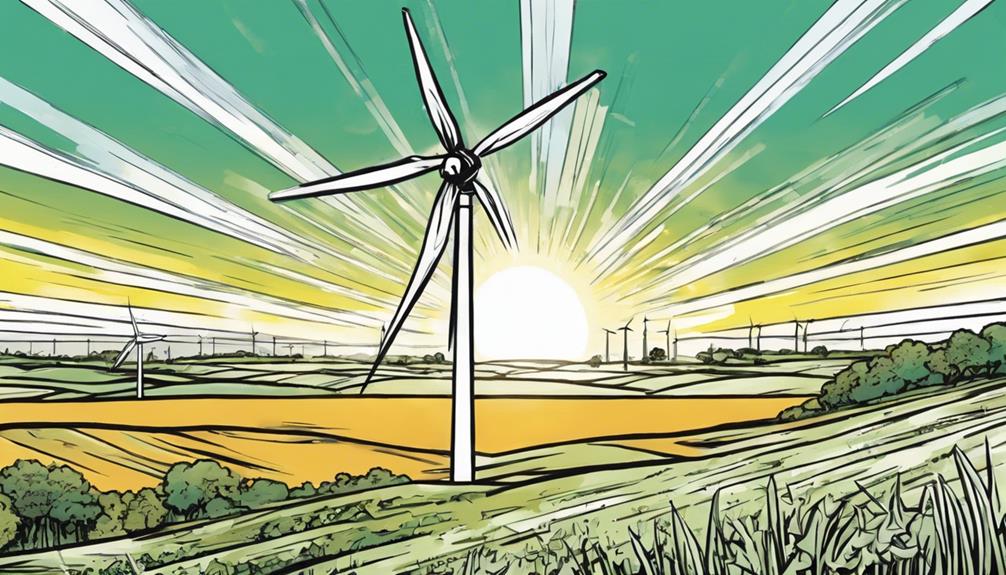
Solar energy indirectly powers wind turbines by converting the sun's heat into wind through atmospheric processes. The sun's energy creates temperature variations on Earth's surface, leading to the movement of air masses that we experience as wind.
These wind currents are what drive the blades of wind turbines, enabling them to generate power. While solar panels directly convert sunlight into electricity, wind turbines harness the kinetic energy of the wind, which is ultimately a product of solar energy.
By capturing this wind energy and transforming it into electrical power, wind turbines effectively utilize the sun's indirect influence on wind patterns. Essentially, wind turbines act as indirect recipients of solar energy, as they depend on the sun's heating of the Earth's atmosphere to produce the wind that they convert into electricity.
This process highlights the interconnectedness of various renewable energy sources driven by the sun's influence on our planet.
Solar Radiation Drives Wind Energy

Solar radiation, with its unequal heating of Earth's surface, plays a pivotal role in propelling wind energy generation. This process occurs through the following mechanisms:
- Uneven Heating: The sun's rays heat the Earth unevenly, causing temperature variations across the globe. As warm air rises and cool air rushes in to fill the void, wind currents are created. This movement of air masses is the foundation of wind energy production.
- Solar Influence: Wind energy, a naturally occurring phenomenon, is a direct result of the sun's energy. Solar radiation drives the Earth's climate system, leading to the generation of wind patterns that can be harnessed for power generation.
- Earth's Rotation: The rotation of the Earth and variances in topography further influence wind patterns. This interaction between the sun's energy, Earth's rotation, and atmospheric processes showcases how wind energy is intrinsically linked to solar energy.
Wind Power: Solar Energy Connection
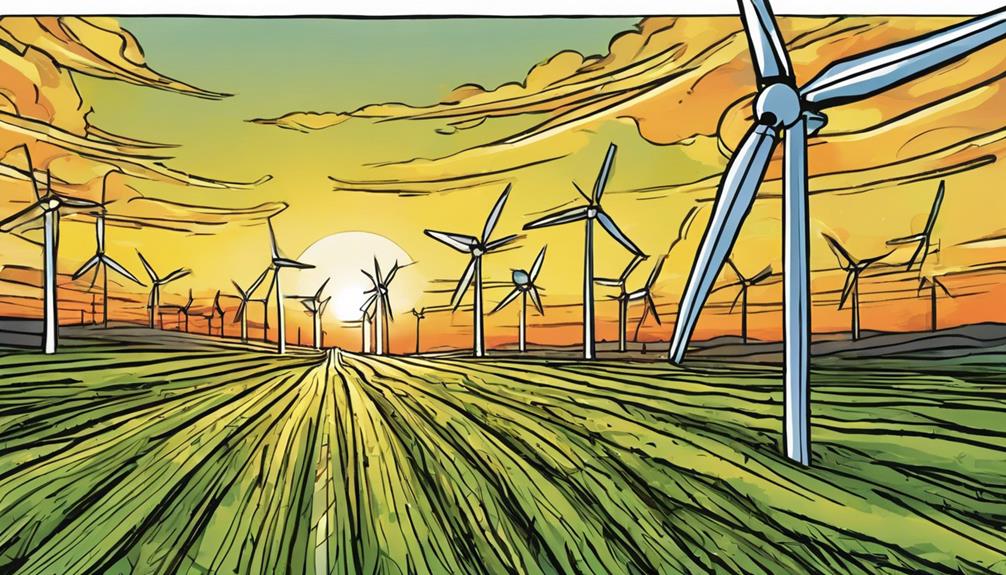
The connection between wind power and solar energy becomes evident when considering how wind energy is fundamentally driven by the sun's influence on Earth's atmosphere. Wind energy is an indirect form of solar energy since it's a result of the sun's heat causing air masses to move due to the Earth's rotation and uneven heating.
As the sun warms the Earth's surface, different areas heat up at varying rates, creating temperature variations that lead to air movement. This movement generates wind patterns that can be harnessed by wind turbines to produce electricity.
Wind power is intricately linked to solar energy through the sun's role in driving atmospheric conditions that result in wind. By capturing the kinetic energy of wind, we're utilizing a renewable energy source that's ultimately powered by the sun, making wind energy an indirect but crucial component of the broader solar energy ecosystem.
Frequently Asked Questions
How Wind Energy Is Considered an Indirect Form of Solar Energy Quizlet?
You're asked about how wind energy is considered an indirect form of solar energy on Quizlet. Wind power results from the sun's uneven heating of the Earth's atmosphere, driving wind currents that power turbines.
Why Is Wind Power Considered to Be a Form of Solar Energy?
To understand why wind power is a form of solar energy, consider this: Wind is formed by the sun heating the Earth unevenly. The resulting air movement powers wind turbines, directly linking wind energy to solar power.
Which of the Following Are Considered an Indirect Form of Solar Energy?
You might consider wind energy as an indirect form of solar energy. The sun's heat creates air movements that spin wind turbines, converting wind power into electricity. This process showcases how solar energy indirectly fuels the generation of electricity through wind power.
How Wave Energy Is an Indirect Form of Solar Energy?
Wave energy, like wind energy, is indirectly powered by the sun through the water cycle. The sun's heat drives ocean currents and winds, creating waves. Devices harness this kinetic energy to produce electricity, making wave energy an indirect form of solar energy.
How Does the Sun’s Energy Contribute to Wind Energy Production?
The sun’s energy plays an indirect role in power sources like wind energy production. Solar radiation heats the Earth’s surface unevenly, creating temperature differences that cause air movement and wind. This wind is then harnessed by wind turbines to generate electricity, demonstrating the sun’s influence on renewable energy sources.
Conclusion
So next time you see a wind turbine spinning in the distance, remember that it's not just the wind powering it – it's the sun's energy at work.
The connection between wind power and solar energy is a fascinating one, showing how the sun's rays indirectly influence so much of the world around us.
Keep exploring the incredible ways renewable energy sources like wind and solar power are changing the way we think about energy production.









